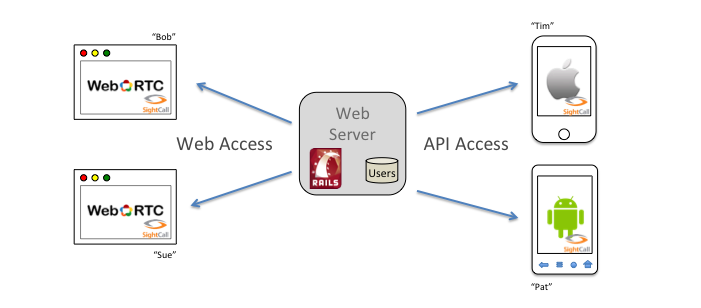This repository hosts an example Rails project that illustrates how to use RTCC to make and receive video calls with a web browser and WebRTC. You can simply check-out and run the example as is, but we suggest using it as a reference as you follow the series of recipes. If you follow the steps of these recipes, you should have a working Rails site that is the same as the one checked in here. In the recipes, we'll give you some tests to run along the way to make sure the project is working. However, if you follow the steps and get stuck, the reference code here can be used to get you back on track.
SightCall's real-time communication platform is built with a strong foundation of "Identity." Each endpoint in a RTCC system is authenticated against an Identity Provider and is granted access to RTC services with a secure token. For this reason, this tutorial is built using a little web-site that implements a Username/Password authentication system to log-in each user.
In addition to using WebRTC in a browser, we are going to extend our Rails application with an API for use by mobile clients. The later chapters in the tutorial describe how to build small RTCC video call apps using this API. The part of the tutorial regarding mobile clients delves into the details of what a back-end service needs to provide to a mobile client, and the steps a mobile client makes to connect to the RTCC Cloud. When done, you will be able to make and receive video calls between WebRTC enabled browsers, and native apps on IOS and Android.
You should have Rails4 installed and you will need a text editor.
You should also have requested a RTCC API Key. If you have not already, you should visit here: http://www.sightcall.com/developers/.
You can completely skip the tutorial and simply configure and run the rails app. You can run it locally, or on Heroku. Here's how.
In Part 1 we show you how to build an extremely simple Rails app with Username/Password log-in and log-out functionality. This gives each user of the application an Identity. The web site has only one main page, and implements a very basic log in and log out mechanism.
The purpose of Part 1 is to provide a website framework in which to embed RTCC functionality. The RTCC platform relies-on and requires notions of identity and authentication. This little Rails framework has just enough to provide a small database of users, each of whom can log in and log out. It is a mini Identity Provider.
If you already have a Rails site that you want to add RTCC functionality too, then you can skip this part.
In Part 2 we integrate the Ruby authentication client from RTCC into our Rails server. Authentication client components are available here: https://github.com/sightcall/Authentication-Client.
The purpose of Part 2 is to show how an authenticated user on a web site may be granted a token to use RTCC video services. The RTCC cloud differs from some other systems in how it verifies the identity of endpoints and maintains the uniqueness of the Identity of each endpoint. This part of the tutorial helps to explain how that works.
In Part 3 we include the RTCC Javascript on the video-call page of our web site. We show how to construct the Javascript to initiate video calls, and we also show how to present a pop-up to answer an incoming call.
At the end of Part 3, you will have a working web site in which different users can log in and create video calls to one another by clicking a button!
In Part 4 we extend the Rails application to provide an API interface for mobile clients. Mobile applications written for iOS and Android that use the RTCC SDK can use these APIs to connect to the Rails "mobile back-end" to get a token and to get a list of friends to call.
In a separate upcoming recipe, we'll show how to write a very simple Android App that can log in as one of the users in the database and can call one of the other users in the database. The other user can be logged in on the Web site, on an IOS device, or on another Android device.
